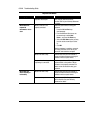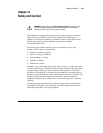
1
4-4
Safety and Comfort
Remember
Remember to exercise regularly and maintain
general fitness. Doing this will help your body
withstand the rigors of sedentary work. Respect
any medical conditions you may have or other
health factors you may know of. Adjust your
work habits accordingly.
Finding Your Comfort Zone
A Range of Positions
Rather than working in a single posture, find your comfort zone. Your comfort
zone is a range of positions that is generally appropriate and comfortable for your
given work situation.
Vary Your Posture
Depending on your tasks, you may find a range
of seated and standing postures that are
comfortable. Within your comfort zone, change
postures often throughout the day.
Move
Sitting still for long periods can cause discomfort and muscle fatigue. Changing
postures is good for many parts of your body, including your spine, joints, muscles,
and circulatory system.
Within your comfort zone, change postures often throughout the day. Take
frequent short breaks: stand up, carefully stretch, or walk around. Frequently
switch to brief tasks that require getting up, such as retrieving output from a
printer, filing paperwork, or consulting a colleague down the hall.
If your furniture offers a wide range of adjustments, you might find it comfortable
to switch back and forth between sitting and standing positions.


















